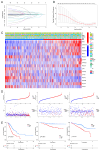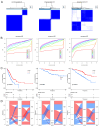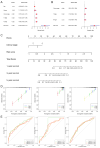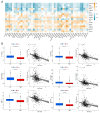Identification of Hypoxia and Mitochondrial-related Gene Signature and Prediction of Prognostic Model in Lung Adenocarcinoma
- PMID: 39006078
- PMCID: PMC11242342
- DOI: 10.7150/jca.97374
Identification of Hypoxia and Mitochondrial-related Gene Signature and Prediction of Prognostic Model in Lung Adenocarcinoma
Abstract
Background: The correlation between hypoxia and tumor development is widely acknowledged. Meanwhile, the foremost organelle affected by hypoxia is mitochondria. This study aims to determine whether they possess prognostic characteristics in lung adenocarcinoma (LUAD). For this purpose, a bioinformatics analysis was conducted to assess hypoxia and mitochondrial scores related genes, resulting in the successful establishment of a prognostic model. Methods: Using the single sample Gene Set Enrichment Analysis algorithm, the hypoxia and mitochondrial scores were computed. Differential expression analysis and weighted correlation network analysis were employed to identify genes associated with hypoxia and mitochondrial scores. Prognosis-related genes were obtained through univariate Cox regression, followed by the establishment of a prognostic model using least absolute shrinkage and selection operator Cox regression. Two independent validation datasets were utilized to verify the accuracy of the prognostic model using receiver operating characteristic and calibration curves. Additionally, a nomogram was employed to illustrate the clinical significance of this study. Results: 318 differentially expressed genes associated with hypoxia and mitochondrial scores were identified for the construction of a prognostic model. The prognostic model based on 16 genes, including PKM, S100A16, RRAS, TUBA4A, PKP3, KCTD12, LPGAT1, ITPRID2, MZT2A, LIFR, PTPRM, LATS2, PDIK1L, GORAB, PCDH7, and CPED1, demonstrates good predictive accuracy for LUAD prognosis. Furthermore, tumor microenvironments analysis and drug sensitivity analysis indicate an association between risk scores and certain immune cells, and a higher risk scores suggesting improved chemotherapy efficacy. Conclusion: The research established a prognostic model consisting of 16 genes, and a nomogram was developed to accurately predict the prognosis of LUAD patients. These findings may contribute to guiding clinical decision-making and treatment selection for patients with LUAD, ultimately leading to improved treatment outcomes.
Keywords: hypoxia; immune; lung adenocarcinoma; mitochondrial; prognosis..
© The author(s).
Conflict of interest statement
Competing Interests: The authors have declared that no competing interest exists.
Figures








Similar articles
-
Prognostic Modeling of Lung Adenocarcinoma Based on Hypoxia and Ferroptosis-Related Genes.J Oncol. 2022 Sep 19;2022:1022580. doi: 10.1155/2022/1022580. eCollection 2022. J Oncol. 2022. PMID: 36245988 Free PMC article.
-
Bioinformatics analysis of an immunotherapy responsiveness-related gene signature in predicting lung adenocarcinoma prognosis.Transl Lung Cancer Res. 2024 Jun 30;13(6):1277-1295. doi: 10.21037/tlcr-24-309. Epub 2024 Jun 7. Transl Lung Cancer Res. 2024. PMID: 38973963 Free PMC article.
-
Construction and validation of a prognostic model for lung adenocarcinoma based on endoplasmic reticulum stress-related genes.Sci Rep. 2022 Nov 18;12(1):19857. doi: 10.1038/s41598-022-23852-z. Sci Rep. 2022. PMID: 36400857 Free PMC article.
-
Identification and validation of a hypoxia-immune signature for overall survival prediction in lung adenocarcinoma.Front Genet. 2022 Oct 3;13:975279. doi: 10.3389/fgene.2022.975279. eCollection 2022. Front Genet. 2022. PMID: 36263421 Free PMC article.
-
Hypoxia-related gene signature for predicting LUAD patients' prognosis and immune microenvironment.Cytokine. 2022 Apr;152:155820. doi: 10.1016/j.cyto.2022.155820. Epub 2022 Feb 14. Cytokine. 2022. PMID: 35176657
Cited by
-
Roles of Hypoxia and Mitochondrial Energy Metabolism Related Genes in Predicting the Prognosis of Liver Hepatocellular Carcinoma.Dig Dis Sci. 2025 Jul 1. doi: 10.1007/s10620-025-09185-7. Online ahead of print. Dig Dis Sci. 2025. PMID: 40593344
-
Machine learning-based model identifies a novel cuproptosis-related mitochondrial gene signature with a key role in the prognosis and treatment of lung adenocarcinoma.Oncol Lett. 2025 Aug 21;30(5):494. doi: 10.3892/ol.2025.15240. eCollection 2025 Nov. Oncol Lett. 2025. PMID: 40904599 Free PMC article.
-
Identification and validation of hypoxia-associated genes positively correlated with HIF1A in pulmonary adenocarcinoma.Transl Cancer Res. 2025 May 30;14(5):3113-3132. doi: 10.21037/tcr-2024-2265. Epub 2025 May 27. Transl Cancer Res. 2025. PMID: 40530158 Free PMC article.
-
Male-specific lethal 1 (MSL1) promotes Erastin-induced ferroptosis in colon cancer cells by regulating the KCTD12-SLC7A11 axis.Cell Death Dis. 2025 Apr 12;16(1):281. doi: 10.1038/s41419-025-07555-7. Cell Death Dis. 2025. PMID: 40221412 Free PMC article.
References
-
- Harris AL. Hypoxia-a key regulatory factor in tumour growth. Nat Rev Cancer. 2002;2:38–47. - PubMed
LinkOut - more resources
Full Text Sources
Miscellaneous

